In November 1952, the world changed forever when William M. Gaines released the first issue of MAD upon an unsuspecting public.
In the intervening years, the venerable bastion of tasteful comedy has informed the humor of generations of readers across several reincarnations. In 1955, MAD switched from comic to magazine format in order to avoid the censorship of the recently established and overly restrictive Comics Code Authority. And several decades later, in 2017, MAD relocated from New York City to Burbank (along with the rest of publisher DC Comics) and relaunched in a bi-monthly format.
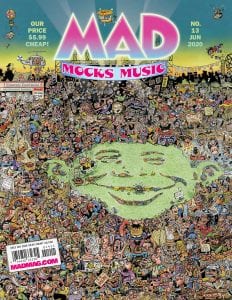
Today, MAD is still going strong, with MAD #13: MAD Mocks Music. The issue is available to read right now and includes new comics from the legendary cartoonists Sergio Aragonés and Peter Kuper. The Beat got the chance to ask these titans of rib-tickling all about their contributions to the most recent issue of the venerable MAD.
First and foremost, we couldn’t resist asking Aragonés about his personal history at MAD. Aragonés has had his comics appear in every issue of MAD since 1963 (except one), and he shared the origin of his “marginals,” the cartoons that characterize the gutters, corners, and blank spaces of every issue.
“I started at MAD in ’62, and my first cartoon appeared in ’63. What happened is that MAD in the old times had little sayings in the borders,” said Aragonés. “I spoke almost no English whatsoever, so I didn’t understand what they were saying. And I would ask an editor, ‘What does this little line mean here?’ And they would say, ‘Have you read this book?’ And I said, ‘No.’ ‘Well then, you wouldn’t understand it.’ Or they would say, ‘Oh, this a quote from this movie, did you see this movie?’ And I said, ‘No.’ ‘Well, then, you wouldn’t understand it.'”
Aragonés continued, “They should be cartoons that everybody understands! So I figured, if I do small cartoons without words on the borders, then everybody would understand it. I presented the idea, and the letters guy said ‘Well that’s very good, but I don’t think he can come up with so many. So let’s publish that until he runs out of ideas.’ And so far, I’m still doing them!”
According to Aragonés, his creative process hasn’t changed much over the decades since his work first appeared in MAD.
“The process is always the same,” said Aragonés. “Try to think of something funny and put it on paper. What changes is the subject matter because growing up in Mexico, my humor was more focused to the Mexican or Latino audience…it was a sense of humor of using cartoons without words.”
“So the surprise was, in the United States at those times, they didn’t like cartoons without words. But MAD did, and that was great because I didn’t have to change really that much except using more international subjects, more MAD, more American. I learned more, because I was learning on the go, which was great. You never stop learning.”
Aragonés explained that he makes an effort to ensure that the widest possible audience will be able to enjoy his cartoons.
“Well, every cartoonist has different subjects,” said Aragonés. “There’s political cartoonists, there’s social commentators and people who do a specific subject, and the people who do advertising. I try to do a generic humor that makes people laugh. So I don’t dwell in politics whatsoever, because I try to please everybody. I make it general humor that every kid can enjoy.”
“So my humor is basically a satire on social lives,” Aragonés continued. “What’s happening to people in general, without getting into the political. And I try to make it without trying to offend people very much, because everybody gets offended if you talk a specific subject. Instead, do it with taste and just make fun of a humorous situation.”
MAD #13 includes a brand new comic from Aragonés, “A MAD look at Port-o-Potties.” Aragonés told the Beat about finding the idea for the fresh cartoon.
“I’ve done so many articles about music,” said Aragonés. “I have done ‘A Mad Look at Concerts,’ I’ve done articles about festivals, about the musicians, about orchestras. I’ve done a lot in the sixty years I’ve been working with MAD. I’ve been doing cartoons in every issue except one.”
“But when it came to the music festivals, they said, ‘Sergio, we are using an older piece of yours’ – the Woodstock piece – ‘What can you think of that’s different?’ I said, ‘I don’t think I’ve ever drawn about the Port-O-Potties.’ They laughed and said, ‘Sure, that makes a lot of sense.'”
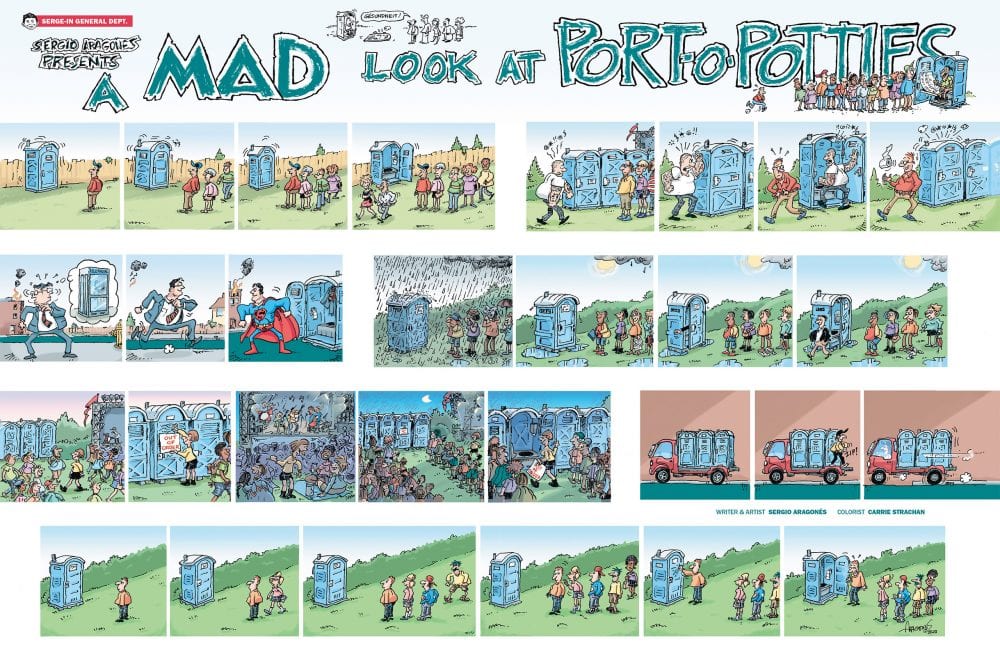
“And then when you think of ideas, you don’t want to be scatological and rude and vulgar, you have to be subtle no matter what the subject is, even with something like a toilet,” Aragonés said.
In addition to the brand-new comic, MAD #13 also includes a reprint of Aragonés’ “I Remember, I Remember: The Wondrous Woodstock Music Fair,” originally printed in April 1970. The comic opens with a mind-blowing 2-page spread featuring hundreds of concert attendees. Where did Aragonés pull inspiration for the many different characters that populate this legendary drawing?
“When you go to the concert, you see people without shirts and you see people with beers and you see people eating and people dancing. So all of them become your models for what you’re doing, but they are not a specific – it’s a generic point of view of everything that’s going on around there.”
“So when you do a piece that has a lot of people – you remember what you saw. And then you look at the pictures that they were taking at the place and you say, ‘That’s so funny! That they’re bathing over there – they are bathing on the river there!’ So now you think of some funny situations to do and you add it into the cartoon. Because everything is fictitious – it’s a humorous interpretation of a concert.”
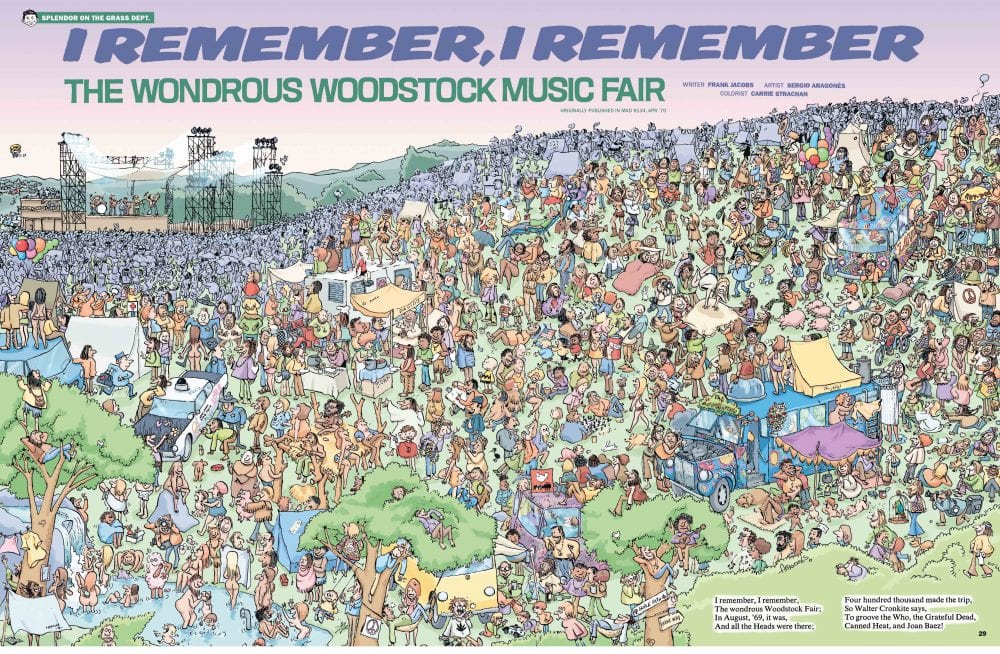
“And you invent more things and then you put all your friends in it and silly things and put characters – a Mickey Mouse walking around, things like that. It’s a lot of fun drawing a crowd because as you’re doing it, you’re laughing a lot because you’re putting a lot of silly things in it. And it’s one of those blessings that I have. I have a career that not only has kept me alive and paid for my mortgage and everything, but it has made me enjoy what I do. I love when I’m drawing. I make silly things and go, ‘Oh, that’s so silly.’ So I enjoy that, still more than ever because to me it hasn’t disappeared or it hasn’t become more difficult. It is as easy as it was when I was young.”
The work Aragonés has done in MAD Magazine has in turn inspired creators for decades. Aragonés credits much of his inspiration to other cartoonists.
“Myself, I’ve been inspired by every cartoonist, young and old,” he said. “Drawing is like playing the piano – you learn, you love it, and you learn from the past masters. You try to emulate lines, you try to emulate subjects, you try to emulate expressions and faces. And sometimes you look at another cartoonist and, ‘Oh my god, look at that, how great he conveys, how well he drafted that particular thing.’ So you automatically absorb it. You don’t copy it, you just learn from it, and do it. So it’s learning from everybody.”
“And it happens exactly the other way,” Aragonés continued. “Many young people or many young cartoonists see your work and they laugh a bit because they like the joke, and they realize, ‘Oh, that’s a very funny cow, or how did he do that, oh, he put certain lines like that.’ So your drawing is a composition of everybody before you.
One artist who was inspired by Aragonés is Peter Kuper. Kuper contributed a new “Spy vs Spy” comic for this issue, a comic he has been working on since 1997.
“I grew up reading MAD,” Kuper said. “The magazine informed my furshlugginer sense of humor. Spy vs Spy‘s creator, Antonio Prohías, and Sergio Aragonés introduced me to wordless cartooning and the idea that images could be an international language. Being given the opportunity to be part of MAD and walk in their footsteps has been an enormous honor. Also it’s a blast to draw mindless violence and explosions.”
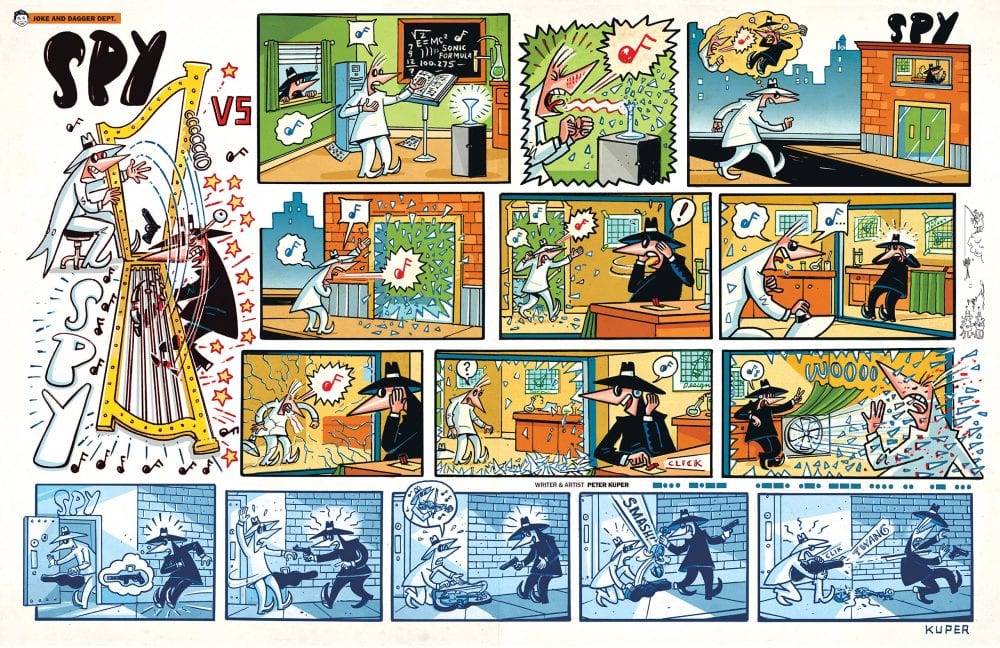
Kuper explained that there were both rewards and challenges associated with cartooning.
“The reward is that I get all of my anger and frustration about human nature and the world out of my system and into the drawings,” he explained. “The challenge is that there are so many new things to be angry and frustrated about in human nature and the world that I would have to draw seven days a week to not lose my mind.”
For his part, Aragonés says that his favorite part of creating cartoons for MAD is the process.
“The first moment when you sit with yourself thinking. It’s like a writer, with the moment that they sit in front of a computer and start writing. I don’t draw immediately – I write the joke. ‘A giraffe is looking for an elephant,’ or whatever. I just write it because I want that spontaneity of the drawing when I do the finished part. So I don’t have to draw it first and then redraw it and redraw it. I go directly to the drawing after I’ve written the joke.”
“And that’s the best moment when you sit by yourself – and I go to a coffee house to think of ideas or I sit in my garden with a cup of coffee and think of ideas.”
However, Aragonés explained that the creative journey may differ depending on the assignment.
“Sometimes they give you a subject that they need, sometimes I come up with the idea myself, like, ‘Well, what about A MAD Look at Boating.’ ‘Oh yeah, that’s a good one, we’ll do it in the summer.’ Or sometimes they call me and they say, ‘Sergio, we need A Mad Look at Wonder Woman.’ So what I do is I go to see the movie a few times, because I want first to see what it’s all about, then I have to see the order of the jokes, and then some details that I need to remember. But that’s how pleasurable it is, the process, the thinking of the joke and then the drawing of it. So it’s the process, yes.”
Aragonés also had some general advice to share regarding the uncertainty people the world over are facing in light of the COVID-19 pandemic. “Just that people shouldn’t lose faith in things, that they should remember that the pandemic will be over,” he said. “Try to take care of other people. And if you are a young cartoonist and you want to continue cartooning, take it seriously. If you want to be a cartoonist, it’ll take years of learning how to draw things. Study about it! Learn everything there is to be learned, and then you’ll become a cartoonist! Spend time to learn, to travel, to experience life, which is what the subject matter is all about. Experiencing life. And that’s applied to musicians and reporters and everybody! It’s learning the craft and getting better. So you take it seriously – continue drawing whatever you’re doing, but learn. And when you’re ready, you’ll be surprised by how good you’ve become.”
You can read MAD #13: MAD Mocks Music right now through ReadDC, Comixology, or wherever you can manage to get your grubby little hands on it.


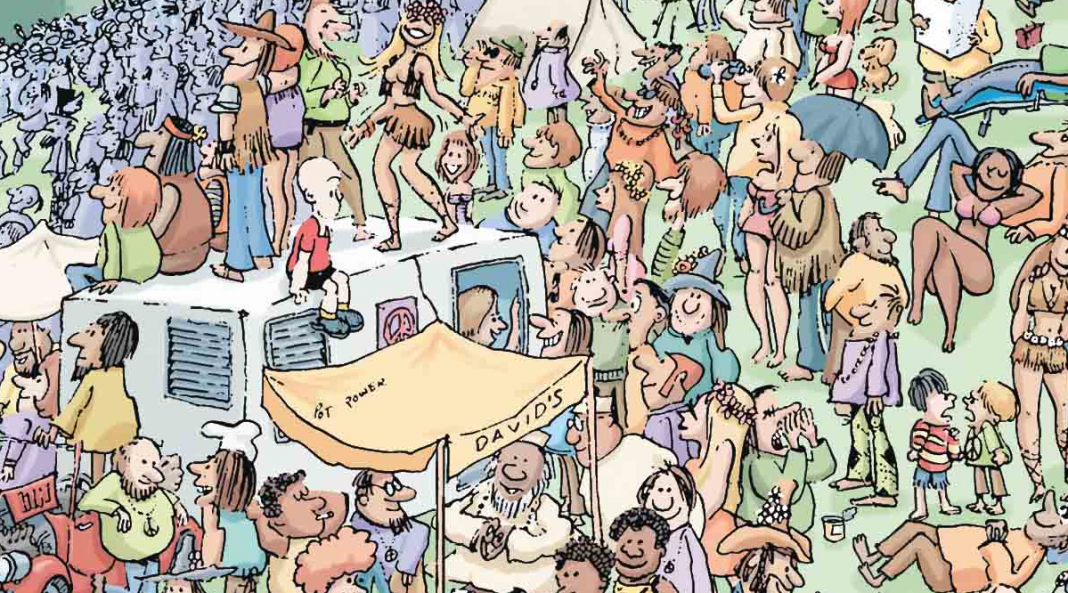
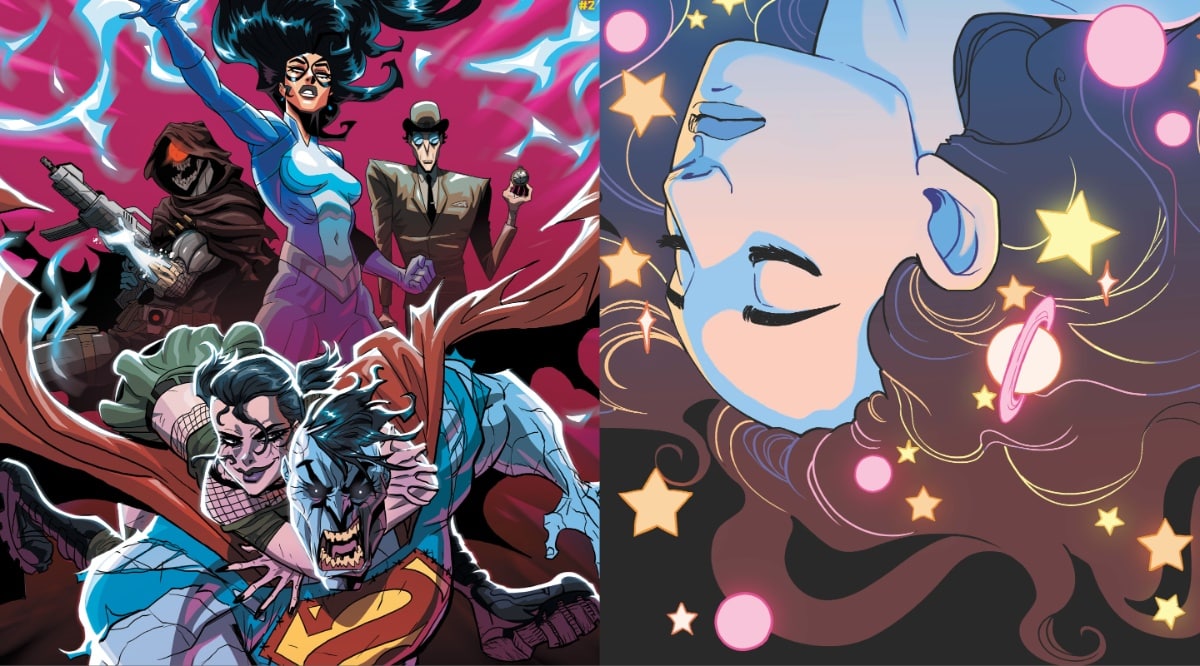





Interviews with Aragones and Kuper are great, but I’d be thrilled if the Beat would investigate the current status of Mad Magazine–mostly new, mostly reprints, all reprints, etc. The 2019 end of year issue indicated that even the Mad staffers were uncertain (and not in a totally joking way).
Comments are closed.